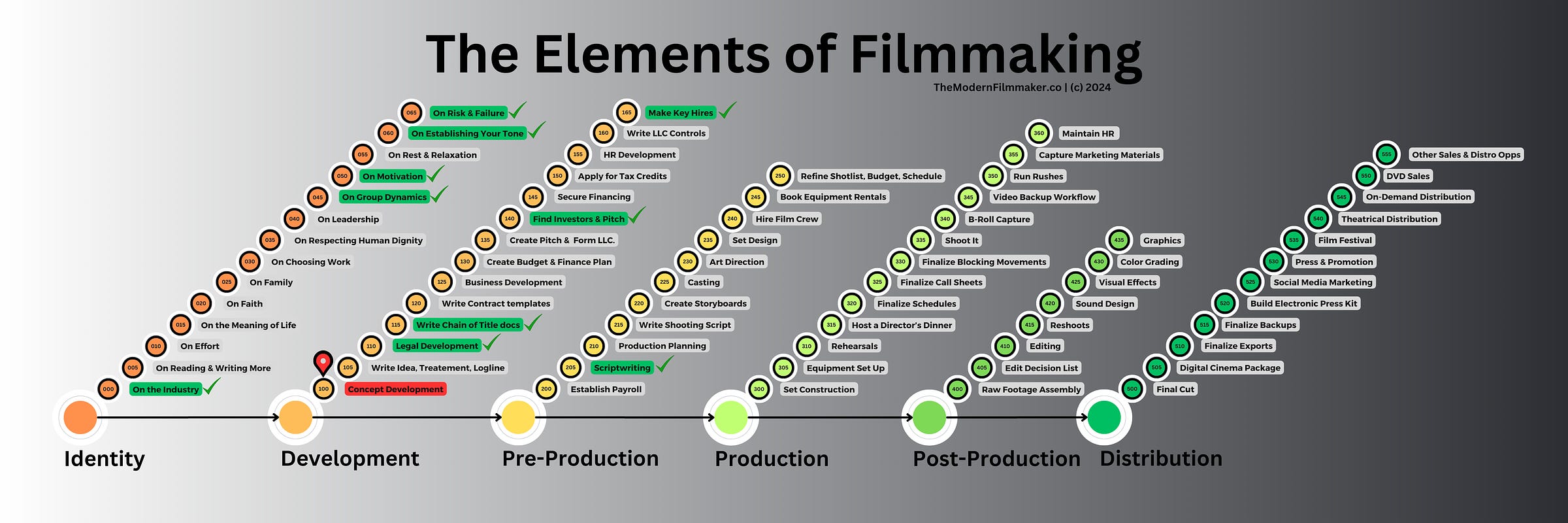Unlock the Hedonic Treadmill to Craft Unforgettable Characters
Discover how the concept of the hedonic treadmill in screenwriting can deepen character arcs and make your filmmaking more impactful.
From a Day of Training Barn Cats (See photos below.)
Thursday, November 14th
Hey Filmmaker,
In screenwriting and filmmaking, one of the greatest challenges is to create characters and stories that resonate deeply with audiences.
We want viewers to see themselves in our characters, to empathize with their struggles and victories.
This is where the concept of the hedonic treadmill comes in—a psychological principle that, when applied to storytelling, can add layers of realism, tension, and emotional depth to your film.
The hedonic treadmill is all about the cycle of desire, fulfillment, and the pursuit of happiness that leads, ultimately, to a return to the baseline.
Understanding this concept can help you craft characters who mirror our own ceaseless striving, making them feel authentic and relatable.
In this post, we’ll explore what the hedonic treadmill is, why it works in screenwriting, and how you can use it to make your films better.
THE MODERN FILMMAKER
This Issue: Unlock the Hedonic Treadmill to Craft Unforgettable Characters…
Last Issue: Cover Your Ass & Your Films with this One Document…
On Sale Now: The Modern Filmmaker’s On Set Filmmaking Dictionary.
So There I Was… (Story)
So there I was, midway through writing a screenplay that just wasn’t clicking.
I had developed a protagonist, Jack, who was relentless in his pursuit of success, going from one goal to the next.
But as I re-read my draft, I couldn’t help but feel that something was missing.
Jack’s journey seemed hollow, like he was just ticking boxes without much reason or meaning.
That’s when I stumbled upon the concept of the hedonic treadmill.
I realized that, like so many of us, Jack was caught in an endless loop of striving for something he thought would finally make him happy, only to return to the same feelings of dissatisfaction and wanting more.
This insight shifted everything.
By embracing the hedonic treadmill, I was able to add depth to Jack’s journey, allowing him to pursue goals that promised happiness but never fully delivered.
This cycle added complexity to his character and gave the story a whole new layer of tension and relatability.
What Is the Hedonic Treadmill?
The hedonic treadmill is a psychological concept that describes our tendency to return to a stable level of happiness despite positive or negative events.
No matter how high we rise or how low we fall, our happiness tends to reset, leaving us chasing the next source of fulfillment.
In screenwriting, this cycle is pure gold.
Characters who are constantly seeking happiness through external means—be it fame, fortune, or love—only to find that fulfillment is fleeting, mirror the real-life experience of the hedonic treadmill.
This cycle adds a powerful, universal theme to your story, making it resonate with audiences on a deep level.
How the Hedonic Treadmill Works in Screenwriting
Applying the hedonic treadmill to your screenplay can create a more dynamic and engaging character arc.
Here’s how it works:
Desire and Pursuit of Happiness
In the first phase, your character sets out to achieve something they believe will bring them happiness or success.
This initial desire fuels their motivation and drives the story forward. This desire could be a personal goal, like achieving wealth or fame, or an emotional need, like finding love or acceptance.
In The Great Gatsby, Gatsby believes that wealth and social status will win him Daisy’s love.
His pursuit of material success is driven by the belief that it will bring him ultimate happiness.
But as we know, this desire becomes a source of endless striving that ultimately leads to his downfall.
Temporary Fulfillment
When the character achieves their goal, they experience a momentary high.
However, this sense of satisfaction is fleeting, and soon they find themselves feeling empty again.
This phase is essential because it captures the audience’s hope that the character has “made it,” only to reveal the hollowness of the achievement.
In Citizen Kane, Charles Foster Kane builds an empire and achieves wealth, fame, and power.
Yet, with each achievement, he becomes more isolated and miserable, ultimately realizing that no external success can fill the void within.
Return to Baseline and New Pursuit
After this fleeting sense of fulfillment, the character returns to their baseline, finding that the happiness they sought was temporary.
They may either spiral into despair or launch into a new pursuit, believing that the next goal will be “the one” that finally brings lasting happiness.
In Birdman, Riggan Thomson relentlessly pursues artistic validation to fill the void left by his fading Hollywood fame.
Each minor success only deepens his dissatisfaction, leaving him trapped in the cycle of never-ending pursuit.
How to Use the Hedonic Treadmill to Deepen Character Arcs
The hedonic treadmill isn’t just about making characters chase after happiness; it’s about helping audiences see the futility of seeking happiness solely through external achievements.
Here are some ways to incorporate this concept into your screenwriting:
Set Up Strong, Motivating Desires
Establish your character’s core desires early on.
Make these desires relatable—perhaps they want recognition, love, or freedom.
These goals should feel like the answer to their happiness, motivating them to take risks and push through obstacles.
Create a backstory that explains why this desire is so important. For example, a character who grew up in poverty might crave financial success, believing it will solve all their problems.
Show the Highs and Lows
When your character achieves a milestone, let them revel in the satisfaction, but only briefly.
Show them savoring the success, but leave subtle hints that this happiness won’t last.
This high point is crucial, as it makes the eventual disappointment more impactful.
Small, symbolic actions—like your character buying a fancy car or moving into a luxury apartment—can emphasize this high. But shortly after, show cracks in their happiness.
Highlight the Return to the Baseline
Once your character realizes that the achievement hasn’t brought them lasting happiness, let them grapple with disappointment.
This return to their baseline is an opportunity to deepen their character, as they start to understand that external success doesn’t equate to fulfillment.
Use subtle shifts in behavior or dialogue to signal this return to the baseline. A character might say, “Is this it?” or reflect a longing for something more meaningful.
Build a Cyclical Pursuit
Make the hedonic treadmill a cycle in your screenplay by setting up multiple goals.
Each goal should feel like a potential answer to your character’s longing, only to disappoint them once achieved.
This cycle not only adds depth but also keeps the plot dynamic and engaging.
Keep the cycle moving by introducing a new goal as soon as your character realizes the previous one didn’t fulfill them. For instance, a character who achieves fame might next pursue love, only to find that both are equally hollow.
🎬 Take the Next Step in Your Filmmaking Journey
Filmmaking is daunting—you know the vision in your head, but turning it into reality feels impossible without clear guidance and tools.
Imagine having a front-row seat to a movie being made and walking away with all the templates, resources, and inspiration you need to make your own.
The WITH LOVE All-Access Pass is your ticket to demystifying the filmmaking process, offering an unparalleled behind-the-scenes experience and every resource in one bundle.
Examples of the Hedonic Treadmill in Iconic Films
Some of cinema’s most memorable characters are trapped on the hedonic treadmill, giving us stories that linger long after the credits roll.
Here are a few examples:
Scarface: Tony Montana’s relentless pursuit of power, wealth, and status ultimately leads to his undoing. Each success brings him closer to his downfall as he realizes that no amount of wealth can bring him peace or fulfillment.
La La Land: Both Mia and Sebastian pursue their dreams in Los Angeles, believing that success will bring them happiness. When they achieve their goals, however, they find that they’ve lost something deeply meaningful along the way—their love for each other.
American Beauty: Lester Burnham initially believes that revitalizing his life with materialism and impulsive desires will bring him happiness. But as he confronts his hollow pursuits, he realizes too late that his true happiness lies in simpler moments with his family.
How the Hedonic Treadmill Makes Films Better
Incorporating the hedonic treadmill into your storytelling adds layers of complexity, making your characters feel real and relatable.
Here’s why this concept can elevate your filmmaking:
Creates Relatable Characters: Audiences connect with characters who seek happiness but struggle to find it, as it mirrors our own experiences with the human condition.
Adds Emotional Depth: The cyclical pursuit of happiness adds tension and emotional weight, making viewers empathize with the character’s highs and lows.
Reflects Realistic Themes: The hedonic treadmill offers a profound commentary on the nature of desire and fulfillment, which resonates deeply with audiences.
Builds Suspense: As audiences watch characters chase after one goal after another, they are drawn in by the hope that maybe this next achievement will be the answer.
Enhances Character Arcs: Characters who experience disappointment and growth feel real and complete, making their journey rewarding and memorable.
Why the Hedonic Treadmill Matters in Filmmaking
To summarize, here’s why the hedonic treadmill is a powerful tool in screenwriting and filmmaking:
Realistic Character Motivations: It captures the universal experience of seeking happiness in a way that audiences understand.
Adds Narrative Complexity: Each cycle of desire and disappointment drives character growth and creates a compelling story.
Engages Viewers Emotionally: Watching characters face the struggles of the hedonic treadmill builds empathy and connection.
Challenges Conventional Storytelling: By showing that happiness isn’t guaranteed at the end of the journey, it presents an authentic perspective on human experience.
Encourages Reflection: Audiences leave with questions and insights about their own desires and what they’re chasing, adding depth to the cinematic experience.
Final Thoughts
The hedonic treadmill may sound like a psychology term, but it’s a storytelling technique that can transform your screenwriting.
By weaving this cycle into your characters’ journeys, you bring realism, depth, and complexity to your film, creating a story that lingers with audiences long after the credits roll.
Embrace the pursuit of happiness as both a motivator and an obstacle, and watch how your storytelling resonates on a whole new level.
Until next time, filmmaker—keep exploring, keep creating, and remember that the journey is often more meaningful than the destination.
Cheers,
Mike Rekola
P.S. Like I promised here’s the photos of our new Barn Cats: Brady and Bella!



P.P.S. Catch up on the rest from TheModernFilmmaker.co:
👉 Buy: The Modern Filmmaker’s On Set Filmmaking Dictionary, today.
👉 Some Filmmakers to Know: Gina Prince-Bythewood
👉 Some Filmmaking Terms: Above-the-Line & Back to First Marks…
👉 Some Stories: So there I was… With a Filmmaker Who Lost It All…
👉 Some Thoughts: Show Don’t Tell Works…
👉 Meet Me: Mike Rekola…






